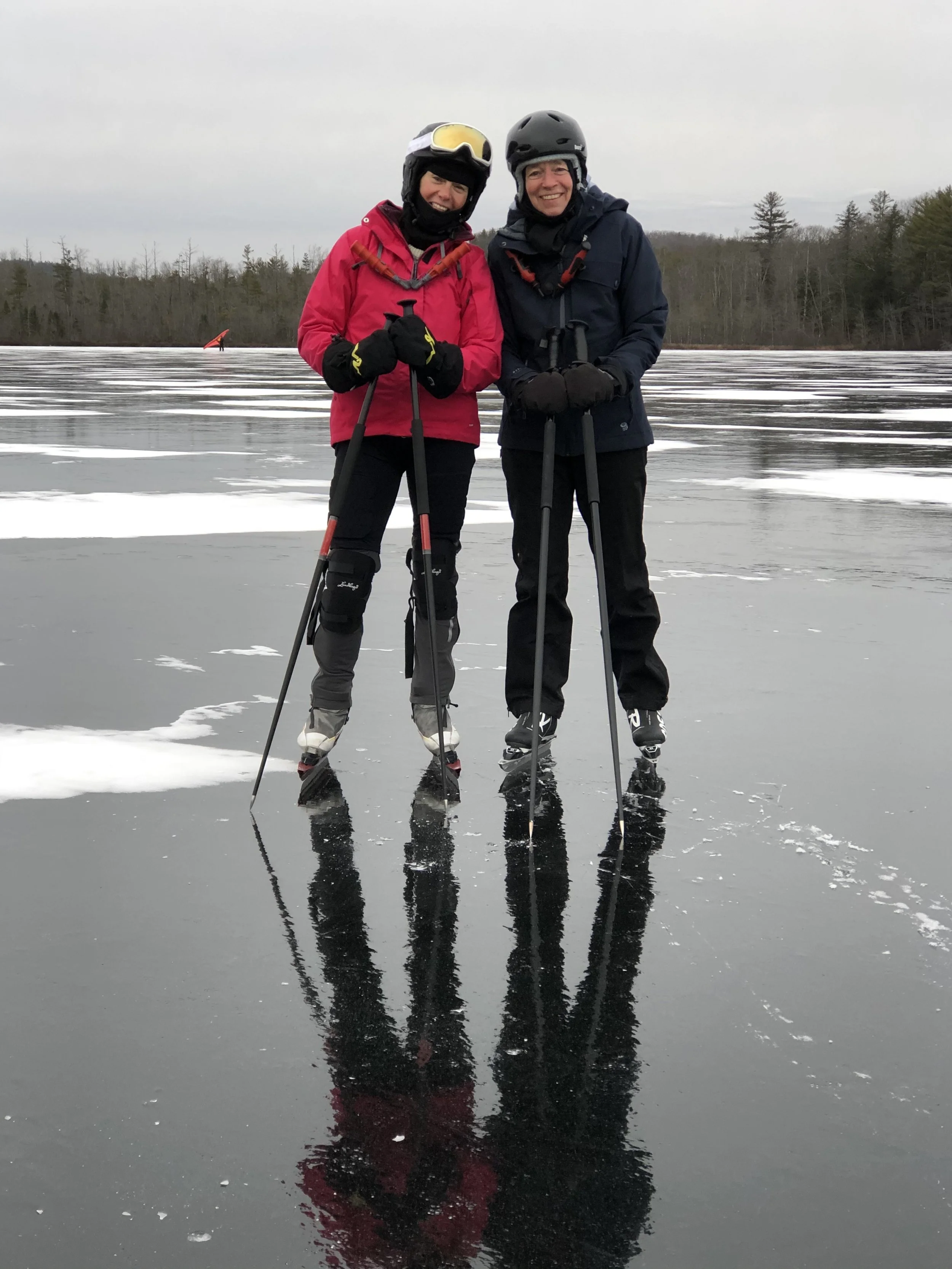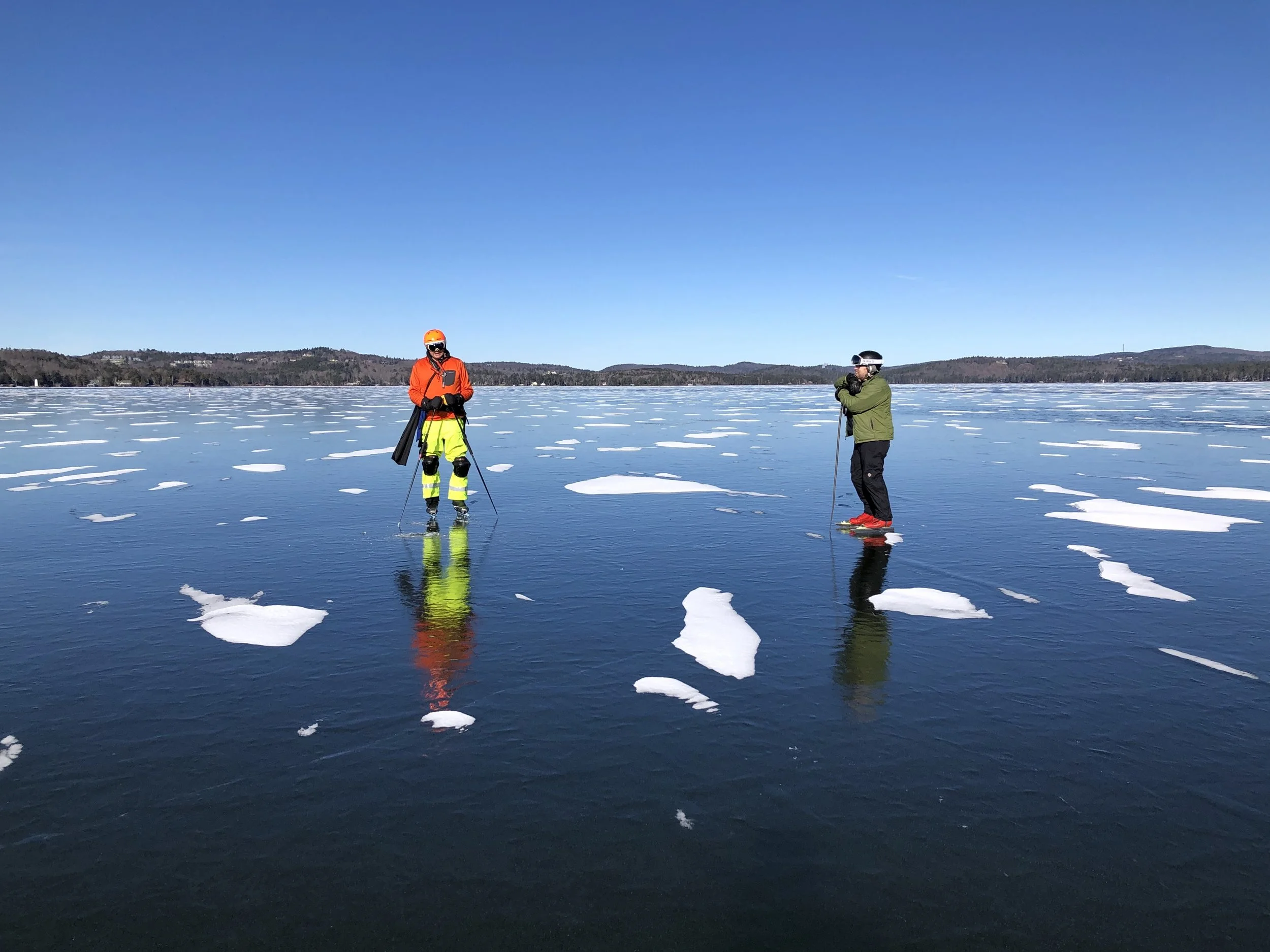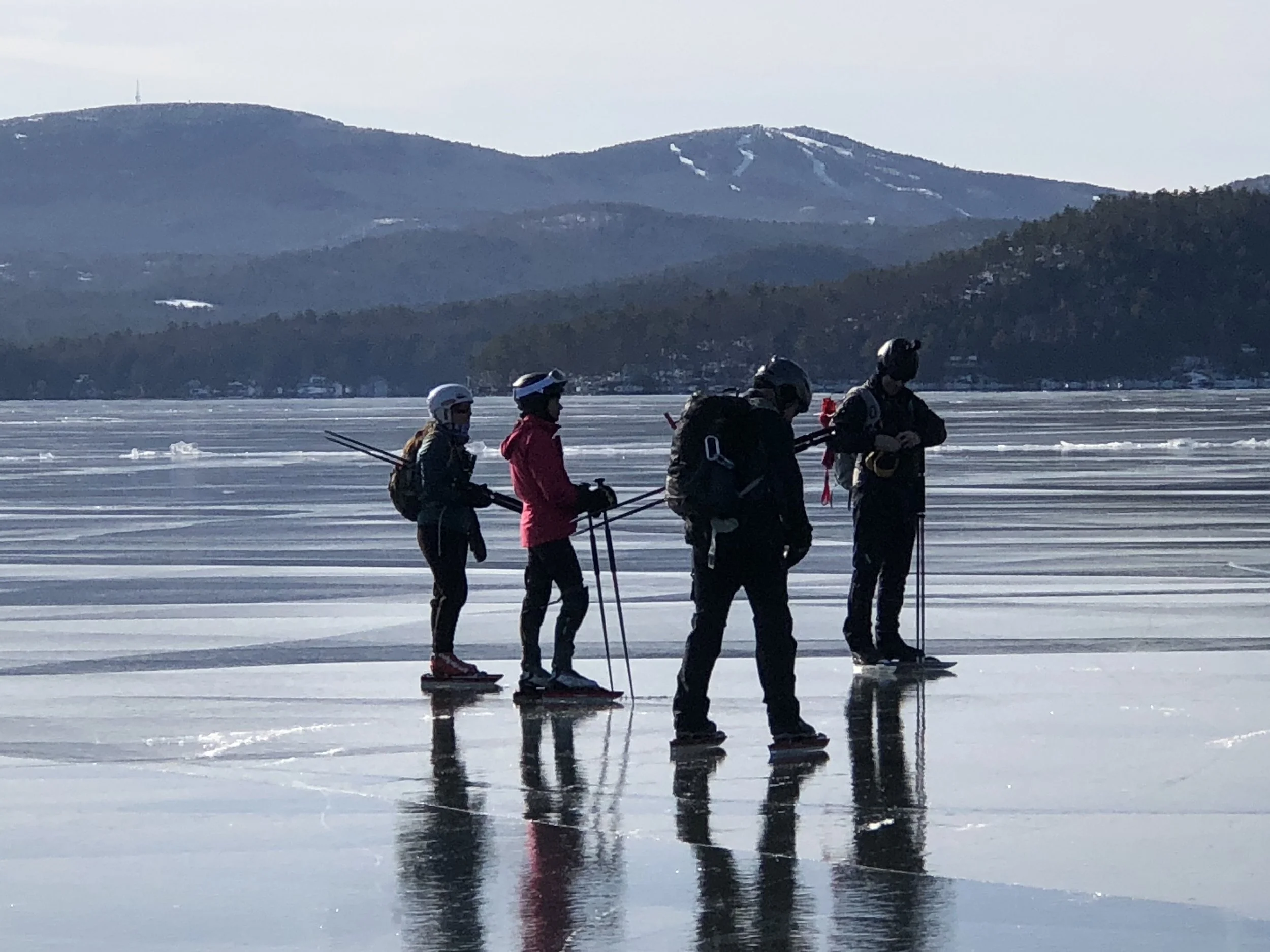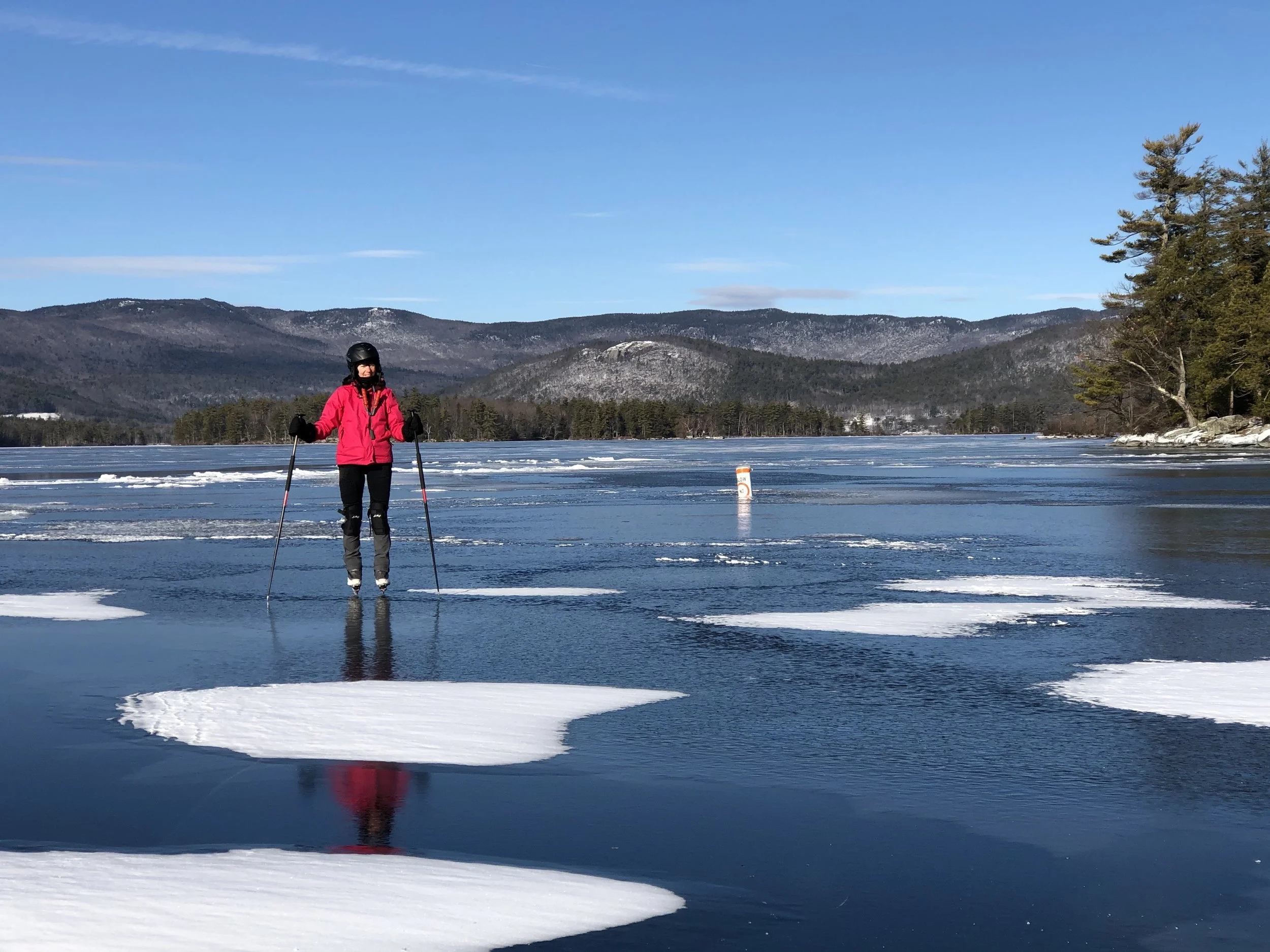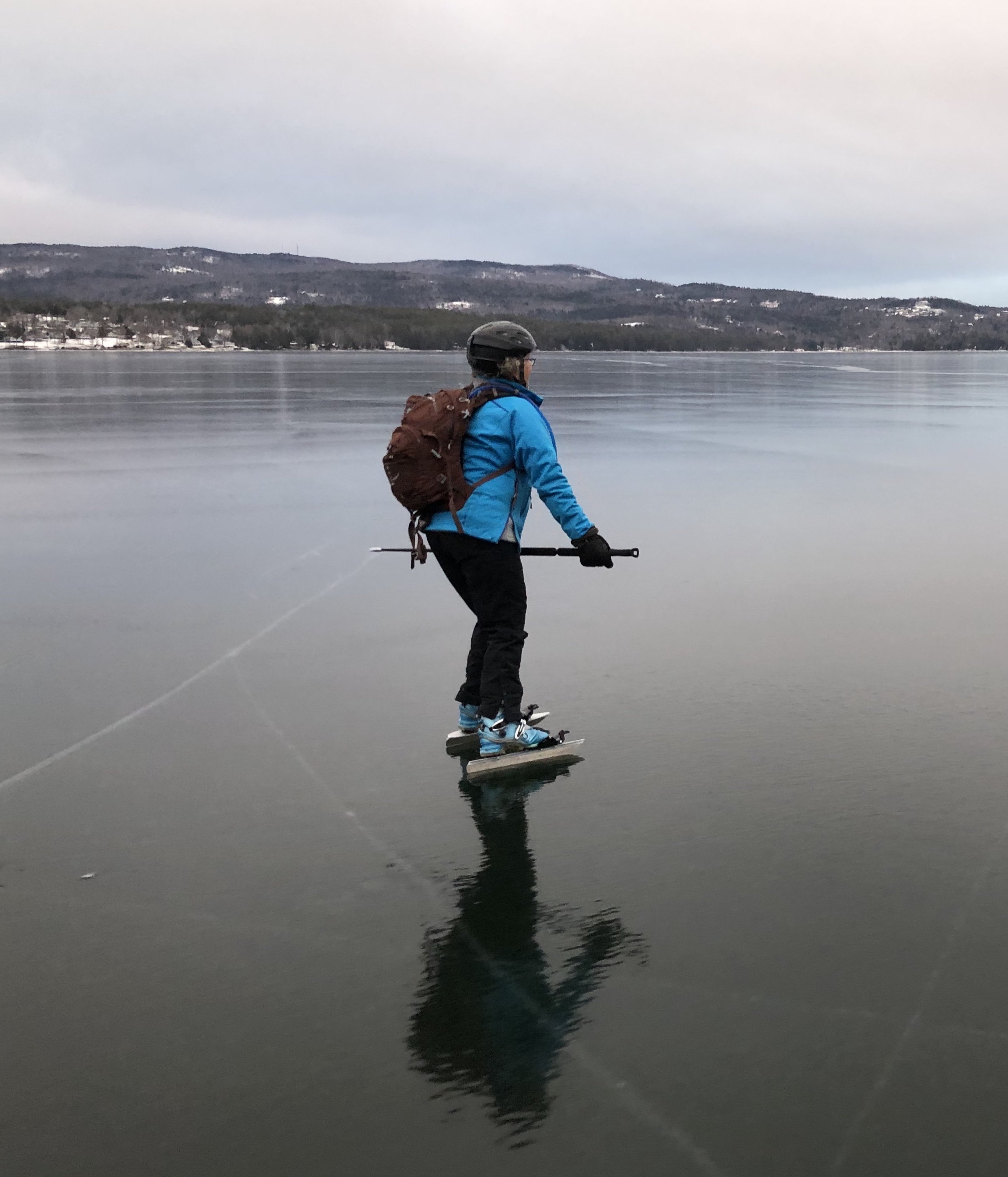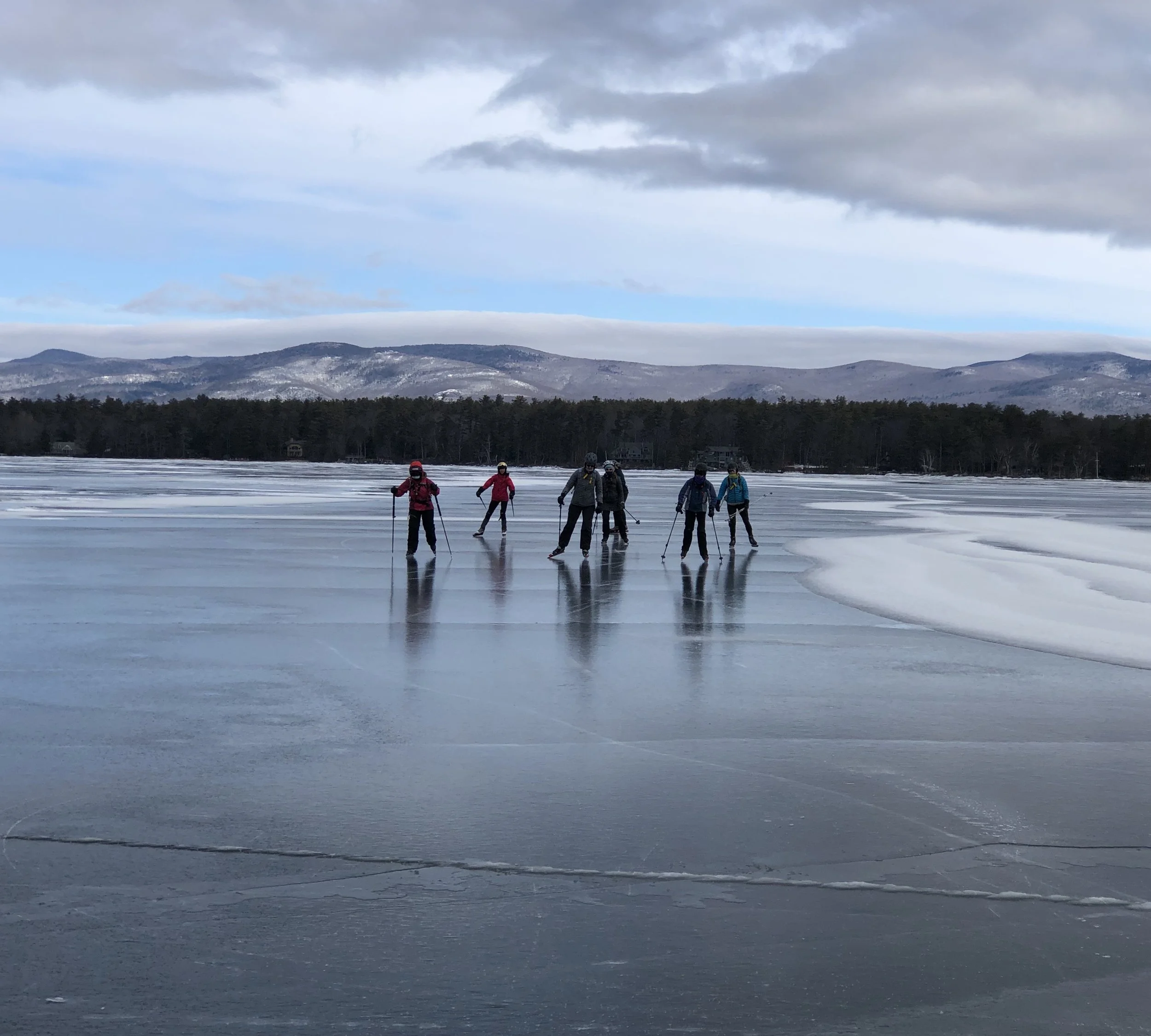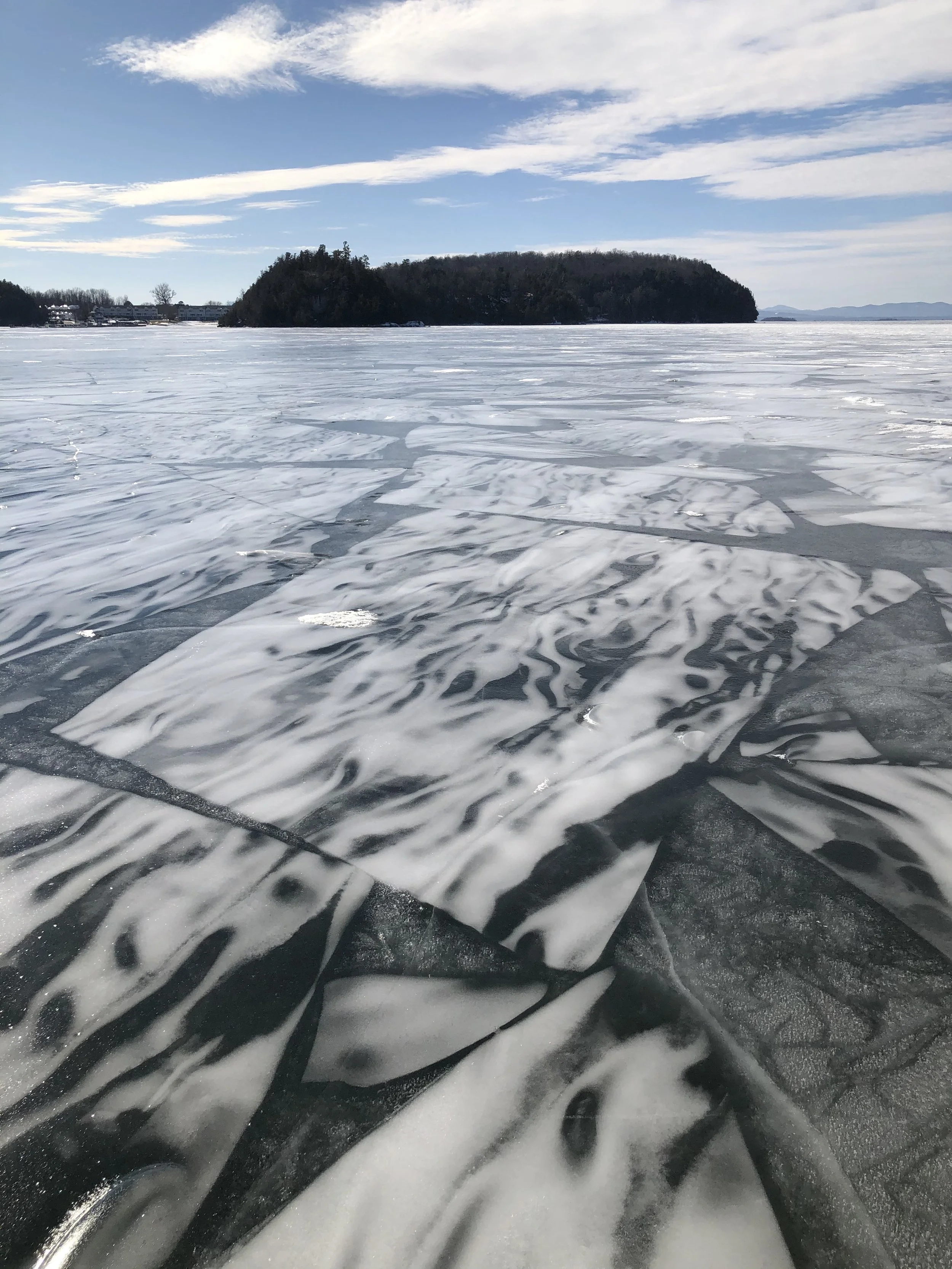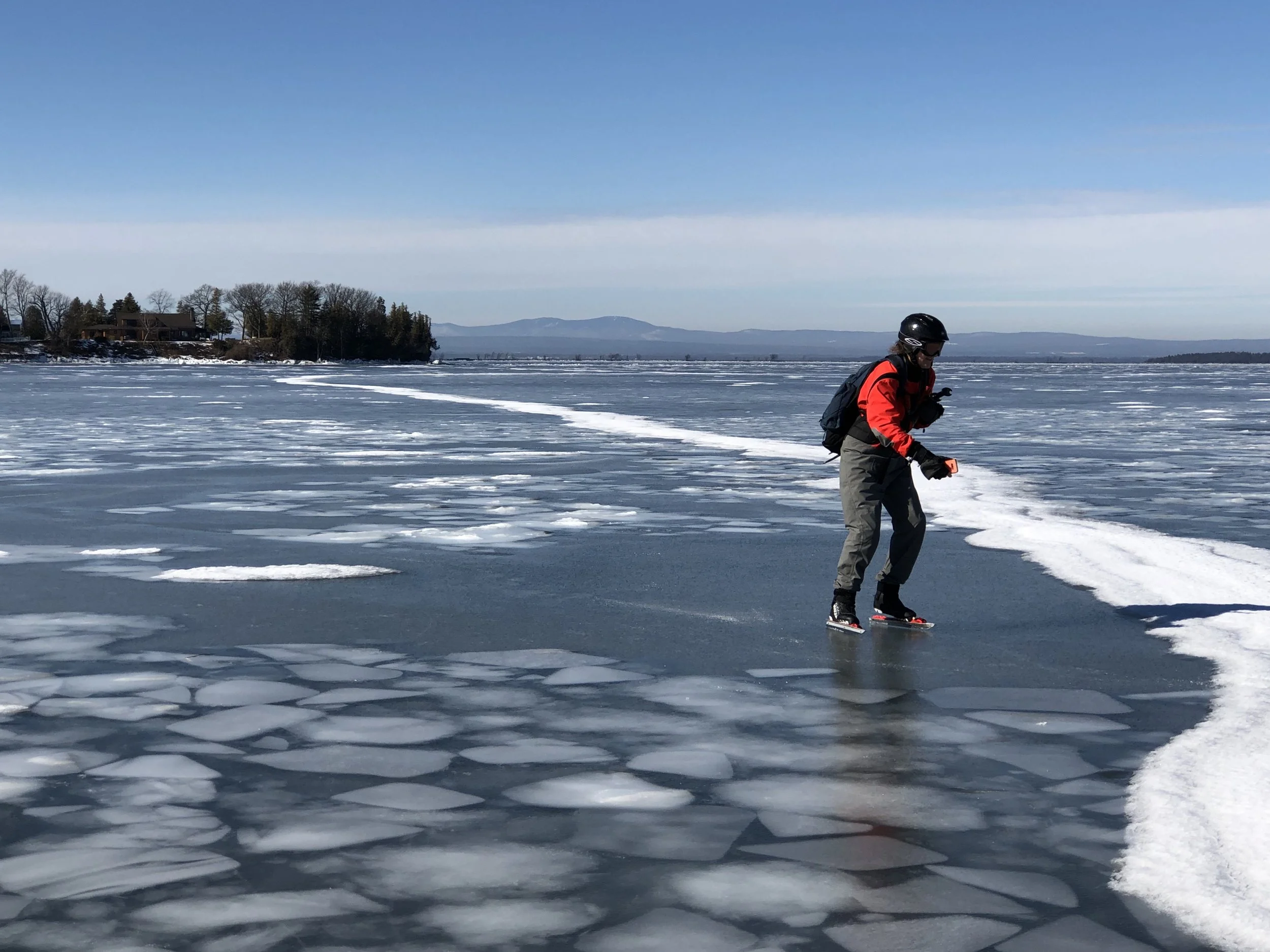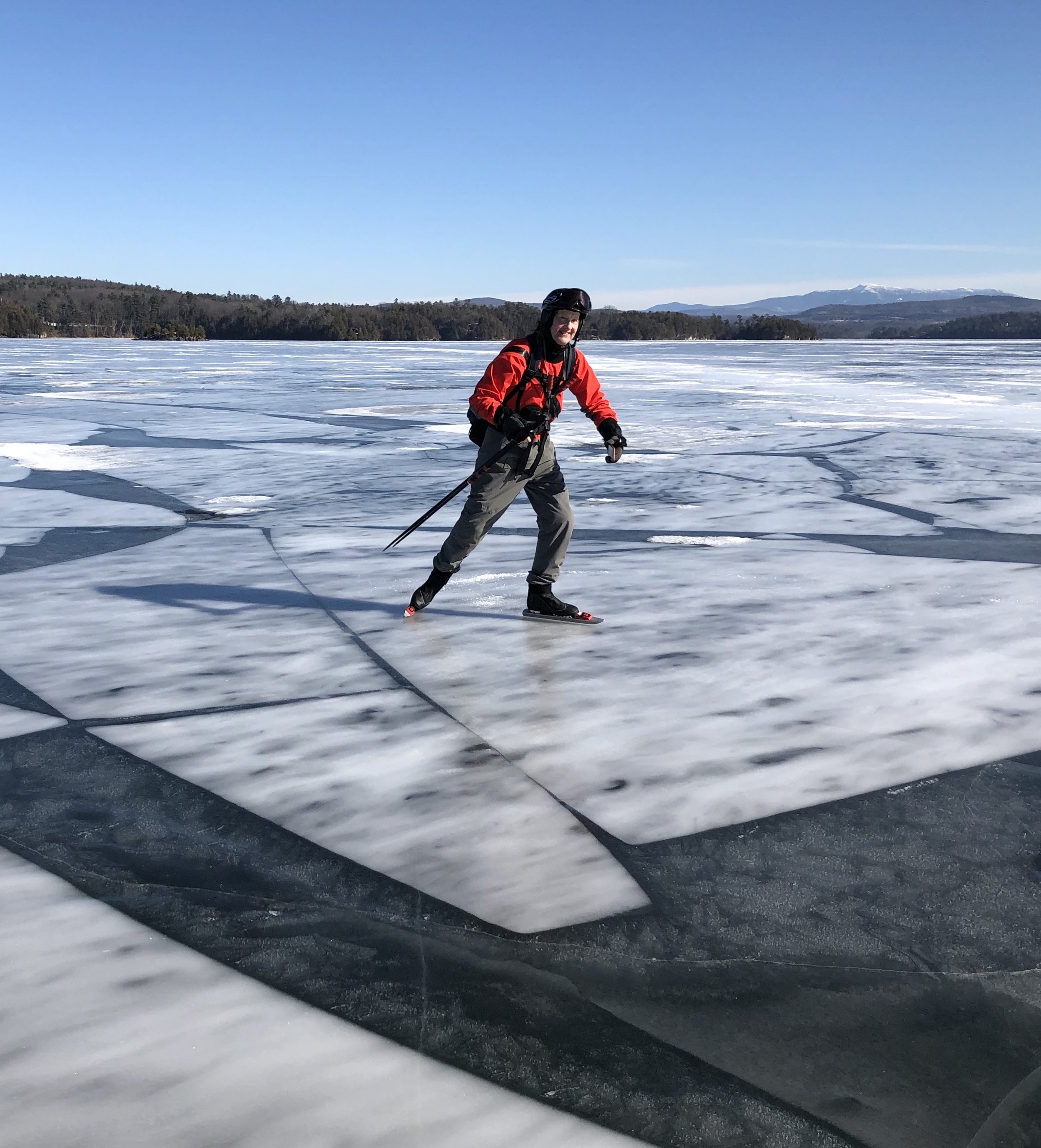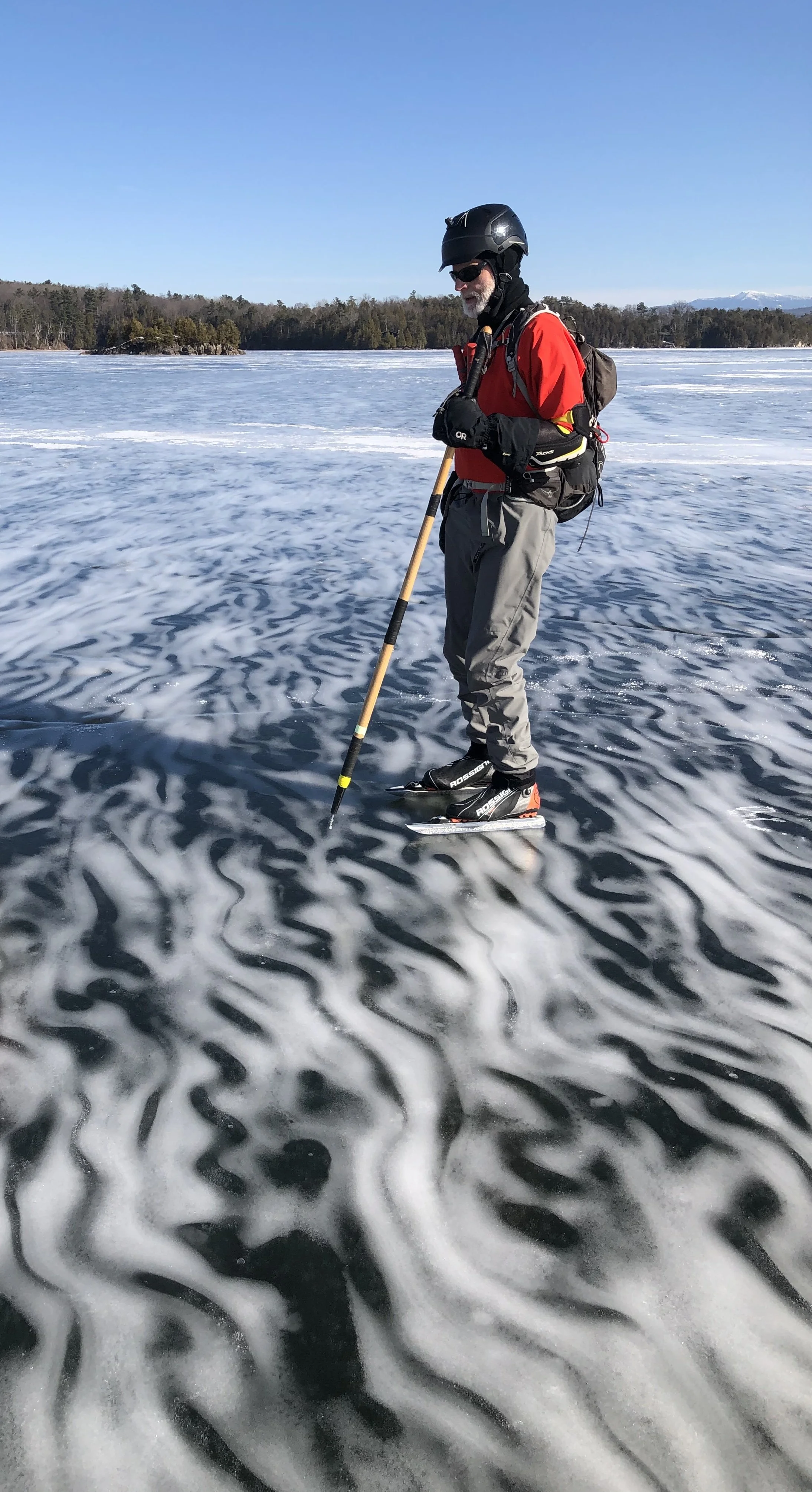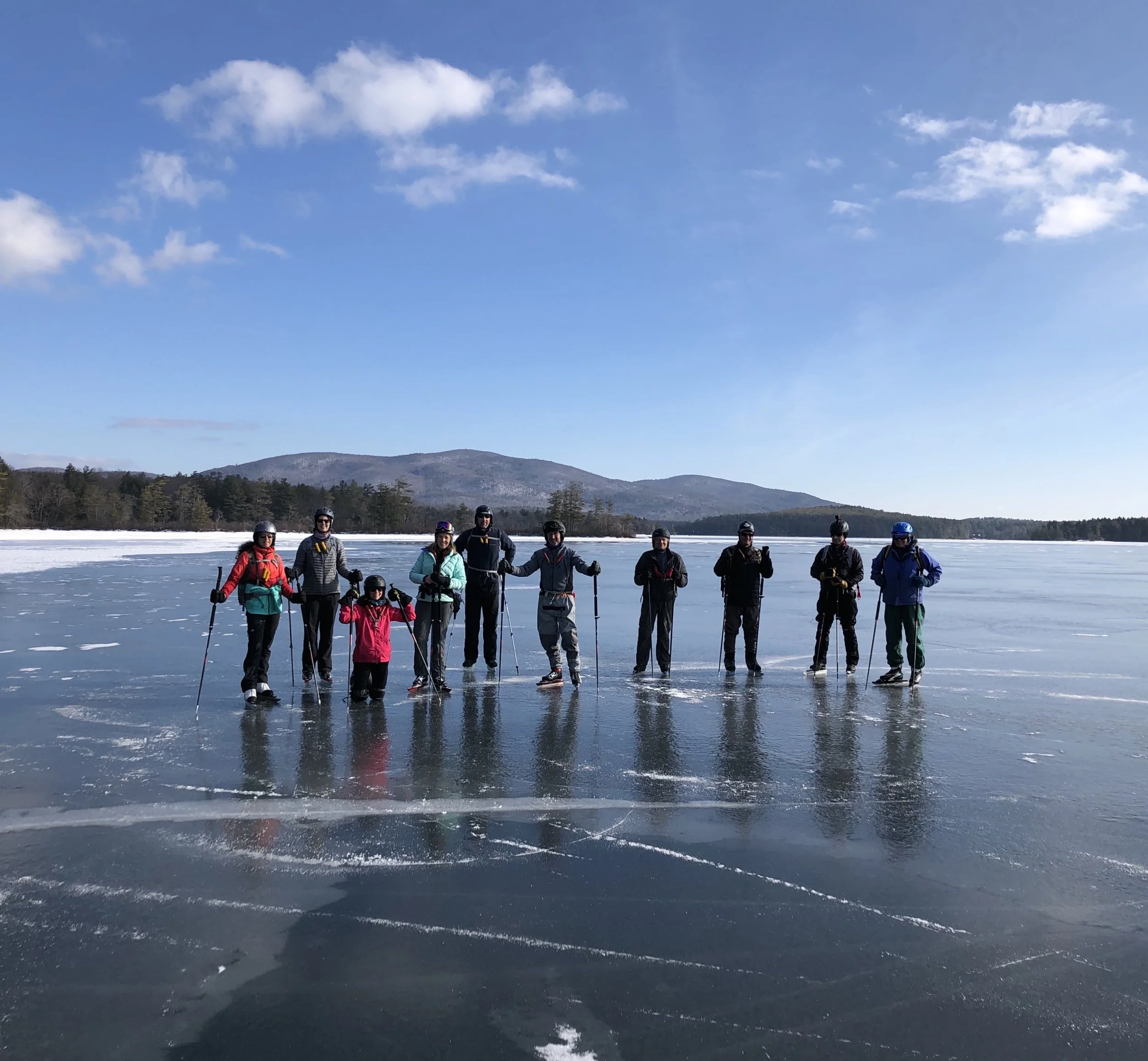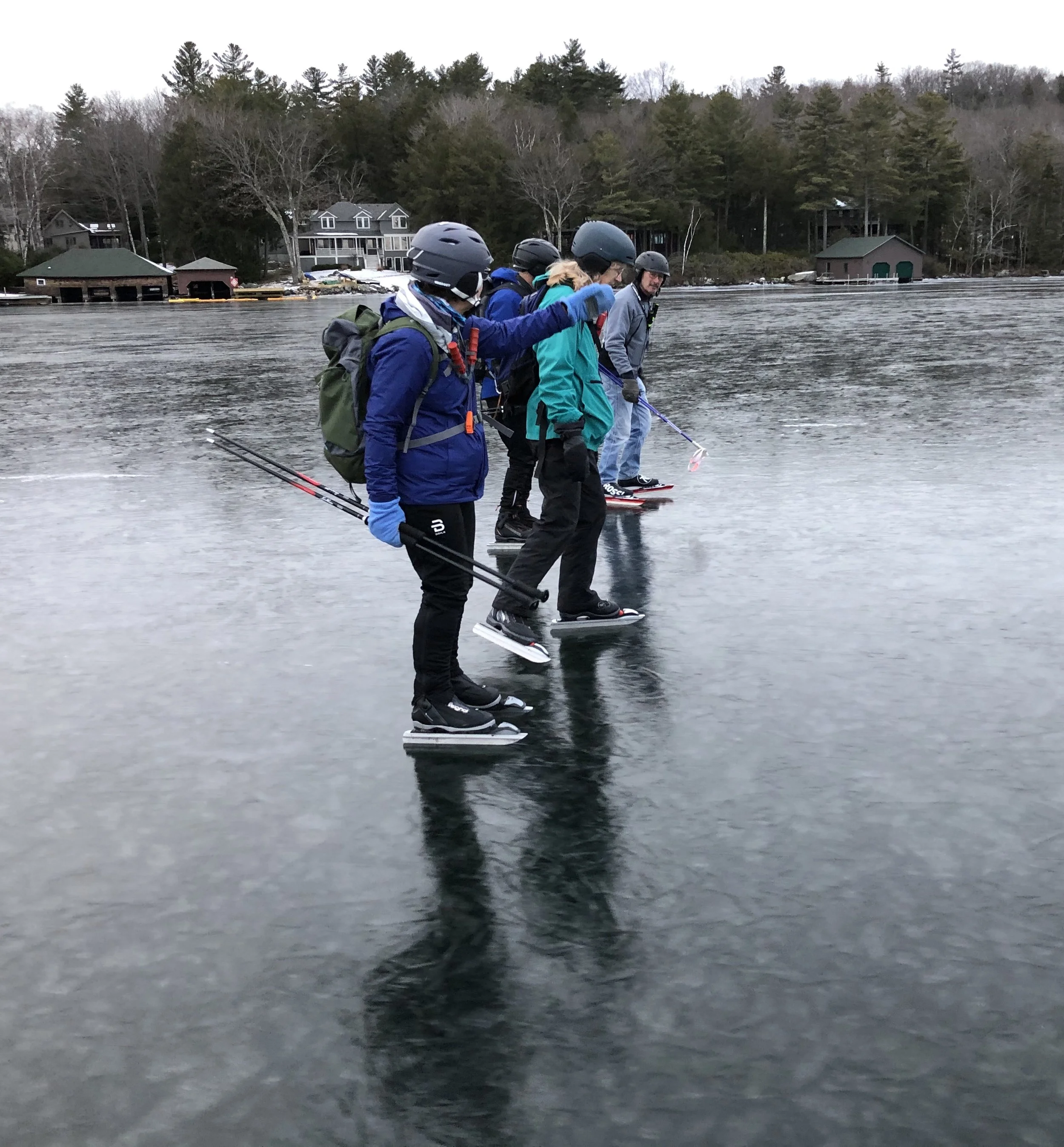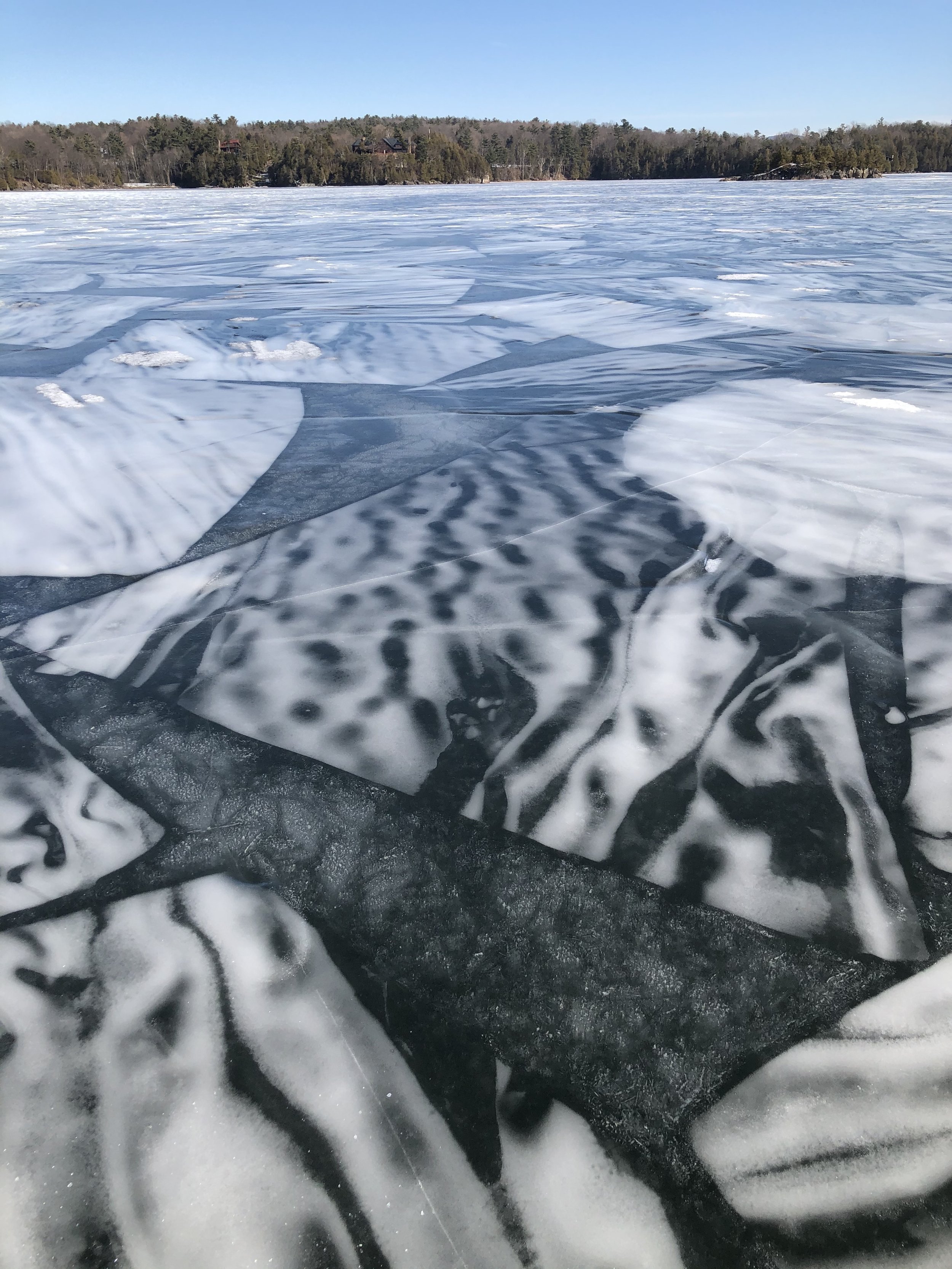by Amy Engeler, Condé Nast Traveler (photos by Jamie Hess)
Macho ice adventures are no longer something you need to fly to Scandinavia for...
When Lake Champlain finally came into view behind some snow-dusted pines and upended boats, my stomach turned over at the darkness of it. All black, sucking up the sunlight on a bright winter morning, the enormous frozen lake - 435 square miles of smooth ice - looked more like a void than a body of water.
Eight of us had convened in a quiet inlet south of Burlington to skate across the lake, from Vermont to New York, in the new sport of wild skating, with a guide leading the way. The danger we faced on this expedition was clear once we stood on the bay beside a few white buoys that were stuck, half-submerged, in the ice. As if in a glass-bottom boat, we could see right through the six-inch ice to the cold water below, where brown algae swayed and the occasional silver minnow moved lethargically along the lake bed. It took no paranoia on my part to imagine crashing through, skates and all, into water so cold that it would squeeze the wind out of me. Not only that but the ice seemed to be taunting us, making loud noises, like the low-pitched moans of a humpback whale.
"That groan, that's a good sound," said our guide, Jamie Hess, a faded red cap above the deep winter tan on his face. He matched us all up with the special steel blades from Sweden, nearly twice as long as those on figure skates, designed to sail over the bumps and cracks in natural ice, and also hung ice claws around our necks, one for each hand. (Basically a nail on a handle, the claw allows a person to pull himself out of the water onto slippery ice, the way a polar bear does.)
"It's the high-pitched sounds that should worry us," he continued brightly. "They mean thin ice." Our group - a set designer from Chicago, a documentary filmmaker, a 70-year-old psychologist, and a local outdoorswoman with a blond Labrador - all nodded silently. Hess then checked the ice by thrusting a pointy ice pole down repeatedly, sending chips flying. "If you hit water on the first try," he said, "that's not safe."
All at once, the lesson was over and Hess pushed off toward the mouth of the bay, leaving behind the calm inlet with its secluded houses and snowy lawns. I'd been looking forward to this very moment for weeks, and yet I felt terribly nervous. I stayed right behind Hess, keeping my head down, my life preserver tight on my back, and watching the ice crack under his blades, long vertical seams that ran out in all directions as the ice eased under his weight.
Truth be told, I knew what I was getting myself into. Wild skating may be new to America, but it's been fairly popular in Sweden since the 1970s. A decade ago, I tried it myself (for Condé Nast Traveler), strapping a life preserver to my back to follow a line of Swedes far out into the fog on the frozen Baltic Sea, as the brackish ice creaked beneath us, sometimes sinking enough to wet somebody's feet. The Swedes, bored with their long winters around Stockholm, discovered that if they pushed the limits of ice strength to the very edge, they could skate for miles on ice only three inches thick. If they fell into the sea, well, they pulled themselves out with picks, ropes, and other, specially designed ice-safety equipment, changed their clothes right there on the ice, and kept going. They learned that a person could survive in 32-degree water for up to 20 minutes. Long-distance skating, or långfärdsskridsko, as the Swedes called it, seemed to me a peculiarly local thing at the time, suited to the Nordic personality and climate. I had lots of good fun and aquavit and returned home figuring that macho ice adventures were something you flew to Scandinavia for.
But over the past four winters, those same lines of skaters, moving in sync over the thin ice, Swedish-style, have been on Lake George in the Adirondacks, along the Connecticut River between New Hampshire and Vermont, on Squam and Winnipesaukee lakes in New Hampshire, and on Lake Champlain - most of the time led by Jamie Hess. He also skated in Sweden a few years after I did, going more than 100 miles up Lake Malaren, but unlike me he returned home to Norwich, Vermont bursting with enthusiasm to introduce that kind of skating to Americans. Within months, Swedish skating equipment filled his barn. Business grew, and two years ago he opened a retail store opposite the old Norwich Inn.
Winter temperatures fluctuate much more in the northern United States than in Stockholm. They bring snow, the bane of outdoor skating, as well as extreme cold (like on the windless night, a week earlier, when Champlain changed from rippling water into three inches of black ice by morning). Hess not only sells the Nordic skates and shows people how to use them but, more important, tells them where the good ice is. An ice geek, he knows what Alberta clippers and sustained low-pressure systems can do to ponds and lakes across New England, how much ice will form on a freezing night (about an inch), and which lakes get "healed" by a winter rainfall instead of flooded and muddy, and he then e-mails out word of his ice tours. Usually he gives only a couple of days' notice - on a Wednesday about a Friday tour, for instance - which means you must drop everything and get yourself promptly to Vermont.
What Hess calls the "big ice" of Lake Champlain is the highlight of the wild-ice season, the largest lake to freeze in the eastern United States (excluding Lake Ontario and the other Great Lakes, whose windswept ice, forming nearly every third winter, is largely unskateable). Champlain is 120 miles long, and in a good year the smooth ice can run 60 or 80 miles from Basin Harbor all the way into Canada. Last season's tour embarked from Burlington's downtown waterfront park, traversing one of the wider parts of the lake, an eight-mile span of nothing but ice. But with skating, as with boating, it's the perspective of the shoreline that makes the lake interesting. So this year, Hess chose a spot farther south, in Charlotte (pronounced the French way, shar-LOT), where, beyond islands with gnarled, wind-beaten trees, the lakefront curves in and out along numerous bays punctuated by summer homes standing on forested bluffs, some with dormers and porches dating back 100 years.
Moving across the frozen lake felt like trespassing. The shorefront homes were deserted, with docks pulled out of the water and porch chairs lashed together against the winter onslaught. Within minutes, our expedition came upon a pressure ridge - the danger point of wild skating -just short of an island. Two big ice plates had separated along a huge crack; as the ice had expanded and contracted, they had been pushed together or pulled apart, leaving a chasm of open water. There are hundreds of these breaking points up and down the lake. They are the barrier beyond which recreational skaters, frolicking in hockey skates and pulling sleds here and on Burlington Bay like in a modern Brueghel painting, don't dare go. A quick sideways step got us, one by one, over the two-foot hedge of ice shards onto ice where none of us would have gone alone.
The wonders piled up: At Garden Island we stood under a frozen waterfall, white tentacles reaching all around us. Bushes covered in ice appeared, looking like marble sculptures. Then, all in a line, my heart pounding, we continued across the lake toward a small brick lighthouse on the New York side. Just like when you cross the state line by road, tidy New England gave way instantly to unkempt wildness in New York. The shoreline rose forbiddingly into steep, wooded hills littered with rocks, with few houses. A small sign on a promontory carried the warning: NO TRESPASSING - RATTLESNAKES. Local hospitals stock the antiserum for the only kind of pit viper left in the Northeast, but it made no difference to us on skates, for the giant snakes (four feet long) were curled up under the snow, hibernating until May. There were other benefits to winter exploring: no mosquitoes, black flies, dragonflies, or bees.
With a gusty wind, we headed south along the coastline and picked up so much speed with these state-of-the-art Swedish blades that it began to feel like flying. The blades have unattached heels and are narrower than those on hockey skates, and extra long - between 15 and 19 inches - with a two-inch tapered curve in front that lifts you over imperfections in the ice. Lake Champlain felt as smooth as an indoor rink. As our skates clicked away, glassy bays opened on our right and then ended at rocky points; thickets of hardwoods quickly passed by, along with an occasional rustic cabin or crumbling fence. The sense of freedom and speed began to eclipse my constant fear. I thought less about the flowing currents under the ice. Hess took out a GPS device, which he carried in a waterproof plastic bag in his pocket. Holding it aloft as if he were photographing himself, he clocked in at more than 20 miles per hour. He seemed, amazingly, disappointed. "I'd go faster if I didn't have to hold this thing," he apologized.
We all scraped to a shuddering stop to look at a ten-inch fish frozen in the ice like some Damien Hirst sculpture, with red blood at its gills. One of the skaters, a man named Chan, mentioned that he'd chased a school of a hundred or so small perch that morning as they darted back and forth under the ice in the Burlington harbor. "This is great," he said, motioning around the lake. "It's gotten to the point where I don't care if it snows anymore."
Although Hess is much more cautious than the Swedes normally are - he didn't propose earning points for falling through as the Swedes do, or even half-points for getting wet up to the waist - the appearance we gave of thumbing our noses at danger became part of the pleasure. Late in the afternoon, Hess and several others reached the edge of the ferry channel, where a car ferry chugs through open water all winter from Charlotte to Essex, New York, using force to push any ice aside. They stared into the churning water, impressed by the precariousness of the ice, when the ship's horn blasted. "Move away from the ferry channel!" the captain ordered over the P.A. system, shocked, or so it seemed by her voice, to see people standing in skates so far out on the lake.
Even off the ice, I found myself moving in the opposite direction from everyone else. While Interstate 89 was jammed with skiers headed to the mountains for the weekend, it was the heart of the off-season in lakeside Burlington. Rooms were plentiful at the Lang House, in the Hill Section near the university, so I settled into a corner room with a view toward the lake and the Adirondack high peaks beyond. Resisting the urge to collapse onto the four-poster (the GPS had measured my skate at 18 miles), I splashed water on my face and headed on foot toward the city's small downtown for dinner.
On a winter evening, with the crisp air scented with wood fires, Burlington looks far grander than a small city on a northern lake has any right to. Mansard roofs, widow's walks, fluted columns, bell towers, and a profusion of other nineteenth-century architectural flourishes make it clear that this was once considerably more than a college town with a JetBlue terminal. The key lies in the broad harbor at the foot of Main Street, its bottom littered with shipwrecks from 1830 to 1862 - the time when Burlington was one of the most important port cities in America, part of a canal system linking it to New York City and Montreal and also the Great Lakes. Waterfront taverns bustled with seamen and lumber traders, and factories brewed up the elixirs that passed for medicine in pre-FDA days. By the early 1900s, that heyday had passed. The local logging industry and farming had stripped two-thirds of Vermont's forests, leaving the state virtually denuded, and Burlington faded into the university town that it is today.
Still, it's the biggest city in Vermont - hard to imagine, given that it has only 40,000 inhabitants. It's also a youthful city, with a median age of 29 (nine years younger than the state's median), which was obvious once I stepped onto Church Street, the pedestrian-only shopping and restaurant drag, and noticed that few people bothered with a winter coat, even at 28 degrees. Along Church were several bookstores, bars open to the street, a nightclub behind silvery curtains, shoe stores, and a French bistro with people spilling out the glass doors as if at an upscale party.
At the bar at Smokejacks, where martini after martini was carried off on waiters' trays, a lone diner, a Canadian guy in a white turtleneck, moved over to talk. I felt sorry for him immediately, not because of his awkwardness but because he was headed to a weekend of skiing with almost no natural snow. Say what you want about global warming, but the past few years have been tough on the ski industry in the Northeast. The cycle of snow and thaw that's a nightmare for skiers can be an opportunity for skaters. Over our local microbrews, I couldn't help feeling smug, knowing the better conditions tomorrow were all mine.
Later, some friends, one of whom sits on Burlington's city council, picked me up in their new hybrid car and took me on a short driving tour of the city. Dispensing with the typical sights, they drove past the home of Burlington's most famous export since the band Phish, former Democratic presidential candidate Howard Dean. The voyeur payoff was high at Dean's modest split-level house because it was set so close to the street that you could actually look into his second-floor picture window. Dean did a widely discussed TV interview in the '70s-era kitchen, standing by a sink with dishes piled high and food on the countertop, which still makes some locals cringe. They thought he looked too much like an old Vermont hippie, unconcerned with appearances (or decor), and that his advisers must have been Vermonters, too, because they didn't interfere with his housekeeping. "Look," said my friend, putting on the brakes. "I believe that's his wife on the couch." As we stared, she turned to see who had stopped.
"Did you see the newspaper? That's why I won't go skating," said Kim Borsavage, the Lang House's wry innkeeper, after fixing my breakfast of poached eggs served over herbed potatoes. She pointed to the front-page headline of the Burlington Free Press, "Skaters Fall Through Ice on Lake," which described how two boys "dropped like a shot" through ice in Burlington harbor and scrambled out unhurt, if traumatized. Any Swede would laugh at a newspaper story like that - as if falling through ice were really news. The newspaper's advice wasn't much help, either. A local Coast Guard petty officer, whose covey of lightplanes we'd spotted flying up and down the lake, advised skaters to prepare themselves by bringing along a friend and a cell phone.
"A cell phone?" said Hess. "How about ice claws or an ice pole?"
The lack of understanding about ice notwithstanding, nearly 30 people showed up on a Sunday morning for Hess's final Champlain tour, including a 13-year-old Norwich girl with light-brown dreadlocks tucked beneath a kerchief and creases of anxiety on her forehead. In Sweden, wild skating is solely for adults - mostly, it seems, so they can push the limits without concern or responsibility. In the United States, Hess outfits families and welcomes kids who can keep up with the pace on his tours. "It's just that I don't want to fall in," the girl said nervously after everyone practiced pulling the ice claws out of their necklace holders in a smooth forward thrust, something we were to do automatically if we plunged into the water.
All day I watched the girl, yet her skating strokes betrayed little. We passed a cove of ice fishermen huddled in their tents and a flotilla of ice sailors racing a course marked by orange cones near Thompson's Point. The girl's mother, in ski tights, confided that her daughter's fear of falling through ice approached a kind of phobia. "I didn't bring her here as therapy or anything," the mom said as we skated over a part of the lake, known for swift currents, that held the wrecks of an 1830s schooner and a canal barge about 270 feet down. "She wanted to do this, and I'm really proud of her. I think she likes it."
The girl witnessed without undue concern the tour's first and only swimmer: A young man crashed through the ice into shallow water on the lake's western shore as he tried to touch a boulder so that he could say he'd been to New York, ignoring the breaking-glass sound the ice made just before he plunged through. With great sheepishness, he undressed on the ice, taking items from those with spare clothing. Not a few people smiled and furtively took out their cameras, relieved it wasn't their mistake and that it wasn't such a big deal after all.
Ice follows a natural progression in New England. The smaller lakes freeze first, usually in December, and can be enjoyed briefly before getting buried in snow. The rivers freeze next, slowed by their currents, and at last, in late January or early February, come the big deep lakes, Champlain and George. Thaws, which heal the ice, bring the opportunity to skate. As winter ends, snow melts off many of the smaller lakes and rivers, sometimes uncovering a foot or more of perfectly good ice that it had kept hard and insulated. After all other winter sports finish for the season, wild skaters often get a second chance to go out on the Connecticut River, Lake Sunapee, or Lake Winnipesaukee.
It would be hard to know from the shoreline of Lake Morey on a glorious spring day that the dull whitish covering on the lake is actually an ice floe ten inches thick and nearly two miles long. "Skating?" said the receptionist at the Lake Morey Resort. He glanced through the picture window at the rippling blue water by the beach, with the gray ice beyond. "Not a good idea," he answered soberly.
Lake Morey, in Fairlee, Vermont, fills a natural hollow between the Connecticut River palisades and the foothills leading west toward Sugarbush and Mad River Glen. It's one of the more lovely and dramatic stretches of Vermont, with the undulating landscape you'd get if, as Helen Husher wrote in her book A View from Vermont, you crumpled a map into a ball, then opened it just enough to tack down the corners. The rolling hills are hell on cell phone service - many residents here don't even bother - but with its open fields, forests, rocky hills, and trim villages, the upper river valley has that comfortable balance between wild landscape and civilized conveniences. You can get Maine crab cakes and coleslaw made of kale with raisins in Norwich, along with unfiltered beer. The Hood Museum of Art, across the river at Dartmouth College in Hanover, has several local paintings that depict the lyrical side of winter and the moments of intimacy which harsh weather can bring to rural communities. Go ten miles up the river and there's not a soul by the brown cliffs that plunge straight down into the icy water.
We can't wade out to Lake Morey's ice floe, so we walk down the eastern shore road past numerous camps, with their aluminum rowboats and canoes pulled up onshore, looking for a spot to launch ourselves onto the ice. Hess finally sets a ten-foot plank under a hemlock tree, making a bridge to the ice over several feet of clear water.
For hours three of us go up and down the lake, past the summer cottages with self-important names such as Anchorage, Red Lodge, and The Maples, or the more wry Ta-kit-ezy. Hess checks the ice repeatedly, dutifully, as Peter, a lawyer from Hanover in wire-rim glasses and khakis, skates with abandon. He heads in different directions, drawn to the weak sections of ice, stopping only when it makes a soggy noise, taking on water under his weight. "Yaooo!" he says, shaking his feet. After a while, I stop caring whether I'll have to pull him out of the lake, as his lack of concern becomes contagious. Something lifts off my chest as I open myself to the possibility of getting wet in this crapshoot of being on thinning ice. I join Peter on a floe the size of a few picnic tables that's broken away and floats like a raft on the water. We move it around with our ice poles and imagine what it would be like to set sail on it on a steamy summer day.
This opaque ice is already losing its lateral integrity. The crow's-foot pattern on the surface will soon press down through the mass, creating vertical ice cylinders the size of pencils that are held together by mere surface tension - until they tumble apart in the water. For reasons I don't understand, the ice doesn't scare me. It's buoyant like a boat. There's nothing tricky about it. You can see it, and it's strong enough to hold us, if barely, in its last stages of melting.
Places + Prices
Onto Thin Ice
by Amy Engeler
Shifting ice sheets, open water, and thin spots are some of the perils of natural ice. The actual skating isn't the hard part - the trick is learning to use the safety equipment and knowing when to turn back.
Most wild skaters in the Northeast learned the technique from Jamie Hess, owner of Nordic Skater, which specializes in Scandinavian skating equipment, in Norwich, Vermont. Hess usually leads about a dozen ice tours in winter, conditions permitting, covering from 10 to 25 miles on Lake Champlain, other New England lakes, or the Connecticut River. The long-distance blades used on these outings snap onto cross-country ski boots and are easily manageable by anyone comfortable on figure or hockey skates. They add magical speed and power, making you feel instantly like an Eric Heiden, which is useful, since the tours proceed at a rapid pace, covering roughly five miles per hour, with short breaks for sightseeing and instruction (866-244-2570; nordicskater.com; blade rental, $20 per day).
Ice conditions being unpredictable, tours are rarely scheduled more than a couple of days in advance, so keep an eye on the New England weather. Snow-free ice usually occurs at times when downhill skiing is at its worst - look for thaws; mid-season rainstorms; long, dry cold snaps; or even mild days and cold nights. Skating usually starts in early December and continues intermittently through March.
Connecticut River
Trips often embark from Dartmouth's boathouse, in Hanover, New Hampshire, which is just 12 miles upriver from the Juniper Hill Inn, a lovely 16-room Colonial Revival mansion on a wooded crest outside Windsor, Vermont. Rooms are large and well furnished, and most have fireplaces. A four-course dinner is served at 7 p.m. Tuesday through Saturday, and you'll feel like you're at a grand house party (802-674-5273; juniperhillinn.com; doubles, $115; prix fixe, $49).
After tours, skaters often congregate at Jasper Murdock's Alehouse at the Norwich Inn, directly across the street from Hess's store, for outstanding home-brewed, unfiltered beer and crab cakes. The crowd tends to be gray-haired and erudite, discussing ancient Greek and art over salads (802-649-1143; entrées, $5-$11). Baked goods abound in the area, thanks to Norwich's King Arthur Flour, which has a flagship store on Route 5, along with a baking school (802-649-3361; kingarthurflour.com).
If the weather turns bleak, Dartmouth's Hood Museum of Art has some provocative contemporary art as well as moody paintings of the local area in winter (603-646-2808; hoodmuseum.dartmouth.edu).
Lake Champlain
Burlington has energy and charm but a paucity of places to stay. Pass up the chain hotels along Route 7 in favor of the Lang House. With four-posters, turreted windows, and hearty breakfasts, it's a friendly alternative within walking distance of downtown and hearing distance of the occasionally raucous University of Vermont campus (877-919-9799; langhouse.com; doubles, $145-$215). Nearby, the handsome Willard Street Inn is somewhat larger, if a bit more frilly. Ask for a room facing the lake (802-651-8710; willardstreetinn.com; doubles, $140-$225).
The restaurant scene along pedestrian-only Church Street and its environs is cosmopolitan and fun, even in frigid weather. A Single Pebble, in what was once a two-family clapboard house, serves a kind of haute Chinese fare by chef Steve Bogart, who refined his techniques on visits to China (133 Bank St.; 802-865-5200; entrées, $16-$18). At the corner of Church and College, Leunig's Bistro is usually packed and sometimes loud with live music (802-863-3759; entrées, $16-$34). Smokejacks, known for its martinis, presents ambitious American fare in quiet surroundings (156 Church St.; 802-658-1119; entrées, $12-$25).
The Borders store on Church Street has a decent selection of Vermont books, including R. W. Vogel's Lake Champlain Atlas of Navigational Charts, which has lake depths and distances as well as the locations of the many nineteenth-century shipwrecks that are maintained as underwater archaeological sites by the Vermont Division for Historic Preservation and marked during the summer by Coast Guard buoys (Lake Champlain Publishing, $25). Henry David Thoreau's fascination with ice borders on obsessive in Walden, which is worth rereading after a wild skate. He mentions a child's game of the 1800s called kittly-benders, which involved running onto thin ice without falling through. Farther north on Church Street, Frog Hollow on the Marketplace, a branch of the Vermont State Craft Center, in Middlebury, is filled with wonderfully weird things made from recycled materials, in addition to the usual pottery and glasswork.
Published in November 2006. Prices and other information were accurate at press time, but are subject to change. Please confirm details with individual establishments before planning your trip.
